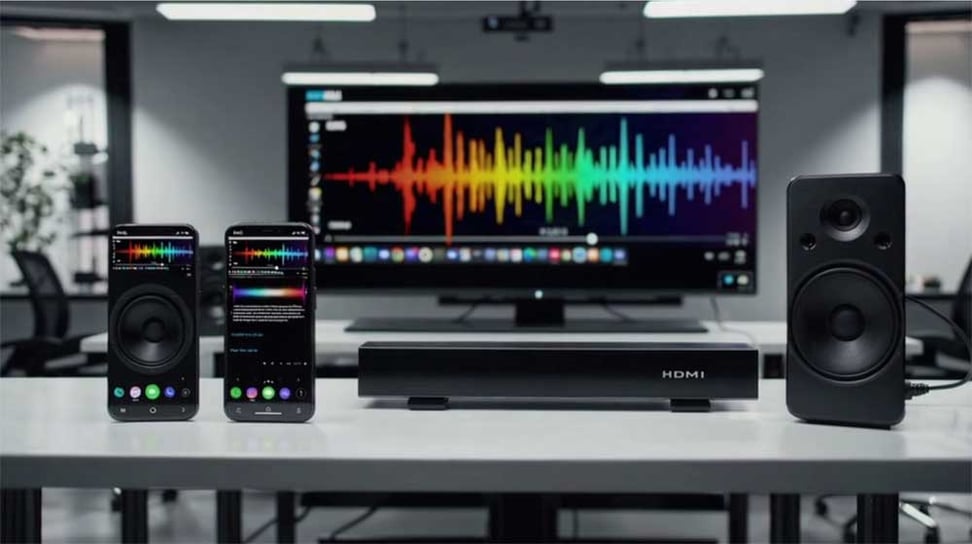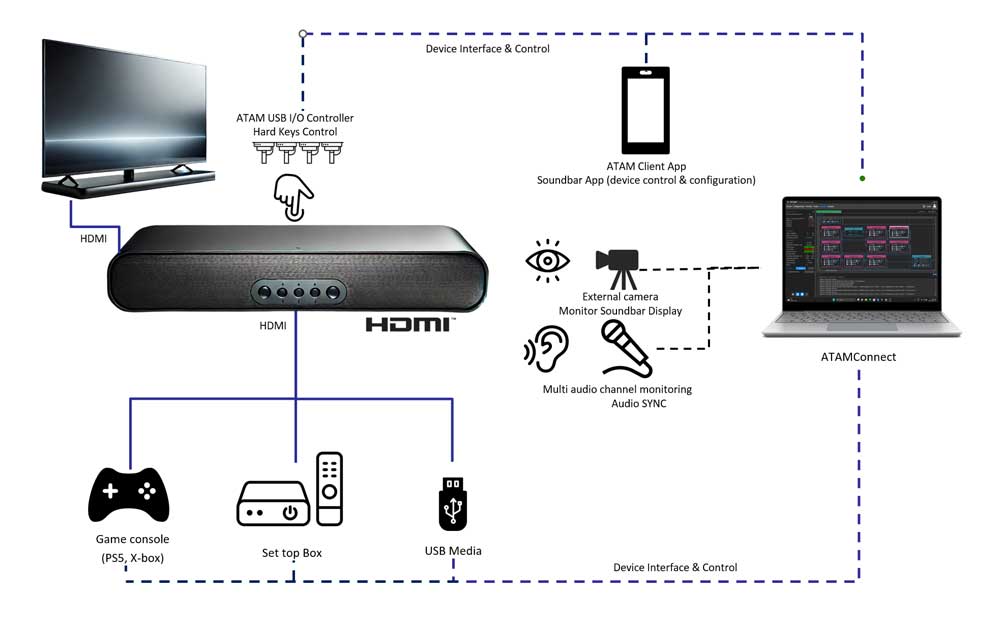Technical Strategies for HDMI Soundbar Testing

Test Strategies for HDMI Soundbars: Ensuring Quality, Latency, and Automation
Introduction
As the demand for immersive, high-fidelity audio grows, so do the technical complexities of bringing a reliable and high-performing soundbar to market. For product developers, managing everything from audio quality to synchronisation with on-screen visuals is critical. With the evolution of HDMI standards (HDMI 2.0, 2.1) and the advent of ARC/eARC, verifying device compliance and performance involves a battery of tests.
This article dives into the technical aspects of HDMI testing, focusing on the specific challenges posed by soundbars. We will cover essential test areas—such as audio latency, lip-sync, and multi-format support and discuss how automation platforms and test services like Nextgen’s ATAMConnect test automation can transform the testing workflow. By employing this systematic, automated approach, developers can ensure more reliable connections, consistent audio quality, and faster time-to-market.
Why HDMI Testing Matters for Soundbars
HDMI stands out as the main conduit for uncompressed digital audio, advanced surround formats, and control signals between consumer electronics devices. For a soundbar any lapse in HDMI performance could lead to:
-
Audio Dropouts
- Poor HDMI handshake or cable quality might cause interruptions, frustrating users during critical scenes.
- Poor HDMI handshake or cable quality might cause interruptions, frustrating users during critical scenes.
-
Lip-Sync Issues
- Even small delays can make dialogue appear detached from on-screen actors’ lip movements, ruining immersion.
- Even small delays can make dialogue appear detached from on-screen actors’ lip movements, ruining immersion.
-
Multi-Format Incompatibility
- Failing to handle formats like Dolby Atmos or DTS:X properly can limit the content experiences the soundbar can deliver.
- Failing to handle formats like Dolby Atmos or DTS:X properly can limit the content experiences the soundbar can deliver.
-
Interoperability Issues
- A soundbar might meet all internal specifications yet fail when paired with certain TV models or HDMI devices. Testing across multiple brands and models is essential for broad market success.
Core Test Types for HDMI Soundbars
1. Audio Quality Analysis
- Frequency Response and Distortion:
Modern testing tools can measure how a soundbar reproduces frequencies across the audible spectrum. Distortion measurements ensure no unwanted artifacts degrade clarity. - Dynamic Range and Loudness:
Some content, like action movies, demand significant dynamic range to avoid clipping during loud explosions or overly compressed dialogue.
2. Audio Latency and Synchronization
- Lip-Sync and Lag:
HDMI ARC/eARC devices can still introduce audio delays. Developers must measure how many milliseconds pass between the video signal and the audible output. Even if the delay is minimal, certain use cases (like gaming) can make any latency highly noticeable. - Compensation Techniques:
Many devices allow manual or automatic compensation for latency. Testing ensures those corrections keep audio in sync across various content types.
3. Codec and Format Verification
- Dolby Atmos, DTS:X, and Beyond:
Advanced surround formats require higher bandwidth and more complex decoding pathways. Confirm the soundbar’s internal processors handle everything from standard Dolby Digital to higher-end object-based codecs without glitches. - Multichannel AAC or FLAC:
Some regions and streaming platforms rely on advanced multi-channel codecs like AAC. Testing ensures consistent decoding or pass-through capabilities.
4. Stress Testing and Error Handling
- Hot Plug and Signal Interruptions:
Consumers might switch cables or input sources on the fly. Testing must simulate these “hot plug” events to confirm seamless transitions and handshake re-establishment. - Fault Tolerance:
How does the soundbar behave if incoming data is corrupted or partial? Does it revert to a safe default, or does it lock up?
5. Video Pass-Through Integrity
- HDR and High-Bandwidth Signals:
Some soundbars offer HDMI pass-through for 4K or even 8K signals. While audio is the main priority, the device must pass the video signal without introducing artifacts or stutters, especially when content includes HDR (High Dynamic Range) metadata.
Diagram: Automated HDMI Soundbar Test
The Importance of Automated Testing
Manual testing for every scenario, multiple TV brands, various firmware versions, and different audio standards can be overwhelming. This is where test automation leveraging Nextgen’s ATAMConnect becomes invaluable.
What is ATAMConnect?
ATAMConnect is a test automation platform that can control and manage various HDMI-connected devices, including TVs, set-top boxes, and soundbars. Beyond HDMI, it also integrates with mobile phones and companion apps, Bluetooth connections, Wi-Fi routers, and other connected hardware devices. This broad scope allows for the creation of sophisticated automated test cases that replicate real-world usage scenarios, significantly speeding up the validation process.
Key Benefits of Automation
-
Consistency and Repeatability
- Automated scripts run the same procedure every time, reducing human error and ensuring repeatable results.
- This is crucial for regression testing, verifying that a new firmware update hasn’t broken previously working features.
-
Efficiency and Cost Savings
- Automated setups run 24/7 if needed, accelerating the time it takes to complete large test suites.
- Fewer manual steps lower the potential for mistakes, ultimately reducing support costs after product launch.
-
Complex Scenario Simulation
- ATAMConnect can coordinate multiple devices simultaneously, allowing realistic scenarios—like streaming from a set-top box to a TV, with audio returning via eARC to the soundbar, all while a smartphone is connected via Bluetooth.
- Automated triggers can introduce momentary signal dropouts to test error recovery.
-
Audio Quality and Synchronisation Measurements
- The platform can integrate with specialised instruments to measure frequency response, distortion, and synchronisation metrics.
- A vision system within the testing suite can analyse video frames to ensure on-screen lip movements match the measured audio signals down to millisecond precision.
Real-World Example
Imagine you need to confirm that your new soundbar can handle Dolby Atmos from a Blu-ray player, pass the video through to a 4K TV, and synchronise the audio. With ATAMConnect:
-
Test Case Setup
- The automated test case include instructions for the Blu-ray player to start playback of a test video with known audio timestamps.
- The TV receives the video signal, while the soundbar receives the audio signal(s) via eARC.
-
Automated Measurements
- The test platform triggers analysis software that records the exact timing of the audible cue.
- A vision system checks the frames of the video for the corresponding visual signal.
-
Pass/Fail Threshold
- If the measured latency is within an acceptable threshold (e.g., 30 ms), the test passes.
- If not, the system flags the test, providing logs to help developers identify the root cause, be it a firmware bug, a problem with eARC metadata, or an HDMI handshake anomaly.
Recommended Test Cases for HDMI Soundbars
-
Basic Audio Pass-Through
- Confirm stereo signals, ensuring no distortion or channel mix-ups.
- Validate ARC/eARC handshake on multiple TVs.
-
Multi-Channel Decoding
- Evaluate Dolby Digital 5.1, DTS 5.1, Dolby Atmos, and DTS:X playback.
- Check if the soundbar auto-detects the format and displays correct indicators (e.g., “Atmos” on the bar’s front panel).
-
Audio-Video Synchronisation
- Use specialised lip-sync test patterns to measure time offsets.
- Evaluate performance with both streaming apps on the TV and external devices like game consoles.
-
User Interaction
- Test volume control via HDMI CEC (Consumer Electronics Control).
- Confirm that powering off the TV also shuts down the soundbar, and vice versa, without error.
-
Wireless and Network Integrations
- If the soundbar supports Wi-Fi-based multi-room audio, confirm it can still handle ARC/eARC data without disruptions.
- Evaluate Bluetooth pairing while HDMI audio is active.
-
Firmware Update Scenarios
- Some issues only arise after an over-the-air update. Automate the update process and retest core features to catch regressions.
Overcoming Common Challenges
-
Dealing with Legacy Devices
- Not all consumers have the latest TVs or cables. Testing with older HDMI versions ensures backward compatibility or at least a graceful fallback mode.
- Not all consumers have the latest TVs or cables. Testing with older HDMI versions ensures backward compatibility or at least a graceful fallback mode.
-
Managing Mixed Signal Paths
- Modern living rooms can include multiple input devices: consoles, streaming sticks, even computers. Each might push unique audio formats, requiring the soundbar to detect and adapt seamlessly.
- Modern living rooms can include multiple input devices: consoles, streaming sticks, even computers. Each might push unique audio formats, requiring the soundbar to detect and adapt seamlessly.
-
Ensuring Interoperability
- The HDMI standard is robust, but real-world device implementations vary. Engaging in compliance programs or referencing official resources (such as HDMI.org’s testing guidelines) helps ensure broad compatibility.
- The HDMI standard is robust, but real-world device implementations vary. Engaging in compliance programs or referencing official resources (such as HDMI.org’s testing guidelines) helps ensure broad compatibility.
-
Scaling Test Infrastructure
- In large-scale product development, multiple teams might run parallel tests on different prototypes. Automated test service solutions like Nextgen HDMI test automation help coordinate resources and maintain a unified set of pass/fail criteria.
Future Outlook: Leveraging AI in Test Automation
While many testing solutions already incorporate advanced scripting and real-time analytics, artificial intelligence stands to further revolutionise automated testing. Using all test logs, traces and data and aggregating these an AI-driven system might predict potential failure points by analysing logs, device states, or historical test data. This predictive capability could flag likely sync issues, memory leaks, or other design flaws before they manifest in actual hardware, further accelerating development cycles. Nextgen are currently developing AI based test analysis reporting systems that do all this and more.
For soundbars specifically, AI can also be employed to “listen” to the output and compare it against a reference track, evaluating nuances of tonal balance or subtle compression artifacts that standard metrics might miss. Combined with a visual inspection system, it is possible validate that on-screen dialogue matches exactly with audio tracks across multiple device interactions.
HDMI soundbars occupy a critical role in the modern home theatre ecosystem, demanding robust connectivity, advanced audio processing, and seamless interaction with TVs and other devices. Testing these features is both complex and essential. By focusing on core areas, audio quality, latency, multi-format support, and reliability product developers can ensure their soundbars deliver the high-fidelity and user-friendly experiences consumers expect.
Automation is key. Utilising Nextgen’s Testing services and automation capabilities not only streamline repetitive test tasks but also improve accuracy, repeatability, and speed. As the home entertainment landscape continues to evolve, with emerging audio formats, higher video resolutions, and AI-driven interface, soundbars that undergo thorough automated HDMI testing will stand out in both performance and reliability.
For any product team aiming to stay competitive, investing in advanced testing methodologies, from basic signal integrity checks to sophisticated automated scripts is no longer optional. It’s a prerequisite for delivering a soundbar that lives up to its promise of immersive, glitch-free audio in an increasingly connected world.
Efficient HDMI Soundbar Testing Solutions from Nextgen
By establishing an integrated environment for HDMI soundbar testing, and especially utilising the latest automation platforms and test services, issues that might slow down time-to-market can be identified and fixed quickly and efficiently.
To find out more about HDMI soundbar testing using automation and advanced diagnostics, and Nextgen's global test and validation services please contact Nextgen or call +44 3331 120 000 or lets set up an online meeting.




